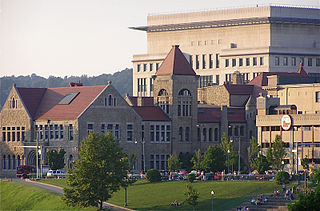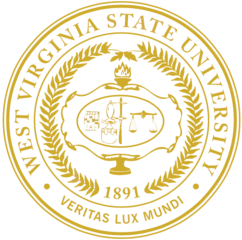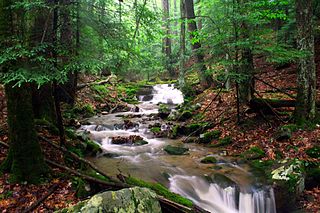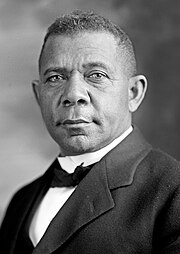
Charleston is the capital and most populous city of West Virginia. Located at the confluence of the Elk and Kanawha rivers, the city had a population of 48,864 at the 2020 census and an estimated population of 48,018 in 2021. The Charleston metropolitan area as a whole had an estimated 255,020 residents in 2021. Charleston is the center of government, commerce, and industry for Kanawha County, of which it is the county seat.

Kanawha County is a county in the U.S. state of West Virginia. As of the 2020 census, the population was 180,745, making it West Virginia's most populous county. The county seat is Charleston, which is also the state capital. Kanawha County is part of the Charleston, WV Metropolitan Statistical Area.

West Virginia State University (WVSU) is a public historically black, land-grant university in Institute, West Virginia. Founded in 1891 as the West Virginia Colored Institute, it is one of the original 19 land-grant colleges and universities established by the second Morrill Act of 1890, which evolved as a diverse and inclusive campus. Following desegregation, WVSU's student population slowly became more white than black. As of 2017, WVSU's student body was 75% white and only 8% African-American.

The Criel Mound, also known as the South Charleston Mound, is a Native American burial mound located in South Charleston, West Virginia. It is one of the few surviving mounds of the Kanawha Valley Mounds that were probably built in the Woodland period after 500 B.C. The mound was built by the Adena culture, probably around 250–150 BC, and lay equidistant between two “sacred circles”, earthwork enclosures each 556 feet (169 m) in diameter. It was originally 33 feet (10 m) high and 173 feet (53 m) in diameter at the base, making it the second-largest such burial mound in the state of West Virginia. This archaeological site is listed on the National Register of Historic Places.

The West Virginia State Capitol is the seat of government for the U.S. state of West Virginia, and houses the West Virginia Legislature and the office of the Governor of West Virginia. Located in Charleston, West Virginia, the building was dedicated in 1932. Along with the West Virginia Executive Mansion it is part of the West Virginia Capitol Complex, a historic district listed on the National Register of Historic Places.
Institute is an unincorporated community on the Kanawha River in Kanawha County, West Virginia, United States. Interstate 64 and West Virginia Route 25 pass by the community, which has grown to intermingle with nearby Dunbar. As of 2018, the community had a population of 1,489, 54% of whom were African American.

James Edwin Campbell was an American educator, school administrator, newspaper editor, poet, and essayist. Campbell was the first principal of the West Virginia Colored Institute from 1892 until 1894, and is considered by the university as its first president.

Holly River State Park is a state park located in Webster County, West Virginia. Situated on the Left Fork of the Holly River near the town of Hacker Valley, it is the second largest park in the West Virginia state park system with a total of 8,294 acres (3,356 ha). The park features over 42 miles (68 km) of hiking trails, ten vacation cabins, an 88-unit campground, and many recreation and picnic areas.
Malden — originally called Kanawha Salines — is an unincorporated community in Kanawha County, West Virginia, United States, within the Charleston metro area.

Cabwaylingo State Forest is a 8,125-acre (3,288 ha) state forest in Wayne County, West Virginia, United States. Cabwaylingo's dense forest was restored and its facilities constructed by the Civilian Conservation Corps (CCC) throughout the 1930s and 1940s. It takes its name from the four surrounding counties: Cabell, Wayne, Lincoln, and Mingo.
The Kanawha River Valley AVA is an American Viticultural Area located in the watershed of the Kanawha River in West Virginia, between the city of Charleston and the Ohio border. The wine appellation includes 64,000 acres (25,900 ha) in portions of Cabell, Jackson, Kanawha, Mason, and Putnam counties. A portion of the western border of the AVA follows the Ohio River, but does not cross into Ohio. The Kanawha River Valley AVA is part of the much larger Ohio River Valley AVA. The hardiness zone is mainly 6b.
Samuel I. Cabell was a wealthy Virginia plantation owner in the Kanawha River valley who may have been murdered for marrying one of his former slaves and providing for their descendants. Although seven white men were acquitted of crime, his will was honored and his descendants went on to lead productive lives. Part of his former plantation approximately nine miles west of what soon became the new state capital at Charleston, West Virginia became West Virginia State University, a historically black college.

The West Virginia Capitol Complex is an 18-acre (7.3 ha) historic district located along Kanawha Blvd., E., in Charleston, West Virginia. It dates from 1925 and was listed on the National Register of Historic Places in 1974.

The Morgan Morgan Monument, also known as Morgan Park, is a 1.05-acre (0.4 ha) roadside park in the unincorporated town of Bunker Hill in Berkeley County, West Virginia. It is located along Winchester Avenue and Mill Creek. The park features a granite monument that was erected in 1924 to memorialize Morgan Morgan (1688–1766), an American pioneer of Welsh descent, who was among the earliest European persons to settle permanently within the present-day boundaries of West Virginia.

The James Rumsey Monument, also known as Rumsey Monument Park, is a municipal park and former West Virginia state park in Shepherdstown, Jefferson County in the U.S. state of West Virginia. The park overlooks the Potomac River. It commemorates local inventor James Rumsey and his successful public demonstration of his steamboat invention on the Potomac in 1787. The monument consists of a 75 ft (23 m) column of Woodstock granite, which is capped with a globe and stands atop a tall, concrete plinth consisting of a 40 sq ft (3.7 m2) plaza.

John Warren Davis was an American educator, college administrator, and civil rights leader. He was the fifth and longest-serving president of West Virginia State University in Institute, West Virginia, a position he held from 1919 to 1953. Born in Milledgeville, Georgia, Davis relocated to Atlanta in 1903 to attend high school at Atlanta Baptist College. He worked his way through high school and college at Morehouse and graduated with a Bachelor of Arts degree in 1911. At Morehouse, Davis formed associations with John Hope, Mordecai Wyatt Johnson, Samuel Archer, Benjamin Griffith Brawley, Booker T. Washington, and W. E. B. Du Bois. He completed graduate studies in chemistry and physics at the University of Chicago from 1911 to 1913 and served on the faculty of Morehouse as the registrar and as a professor in chemistry and physics. While in Atlanta, Davis helped to found one of the city's first chapters of the National Association for the Advancement of Colored People (NAACP).

William H. Davis was an American educator and school administrator in the U.S. state of West Virginia. Davis was the first formal teacher of Booker T. Washington, and he was the first and only African-American candidate for governor of West Virginia, running for the office in 1888.
Mary Barnes Cabell (1815–1900) was an American freedwoman who enabled the foundation of Institute, West Virginia. Her story was dramatized in a movie in 2020 called River of Hope.


















